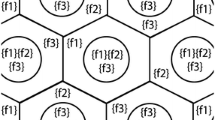Abstract
In the last five years, transmissions using multiple sensors at both ends of the link have been a major research topic. Many transmission schemes are studied such as point to point links using diversity coding, point to point links using multiplexing, tradeoffs between both and at last multi-point to point links. This last scheme was already covered by Space Division Multiple Access (SDMA) processing but a step forward was made with multiple subscriber detection. This paper asses the multi-point to point links for uplink and point to multi-point for the downlink based on OFDM waveform in the frame of the Wireless Metropolitan Area Network (WMAN) IEEE Std 802.16-2004 or HIPERMAN standard. It describes a realistic implementation of transceivers for Physical (PHY) layer to Medium Access Control (MAC) layer allowing a system capacity increase with minor modifications of the standard and with a low impact on the complexity of the subscriber equipment. In this context, this paper proposes to focus on based-band techniques: The Obèle algorithm based on the channel knowledge in the downlink and multiple-user detection in the uplink. The algorithm complexity and the tradeoffs for implementation are extensively discussed.
Similar content being viewed by others
References
Joël Bertrand and Philippe Forster, “Optimal Weights Computation of an Emitting Antenna Array — The Obèle Algorithm”, IEEE Transactions on Signal Processing, Vol. 51, No. 7, July 2003.
Lionel Biard and Dominique Noguet, “An Adaptable Architecture for the Viterbi Algorithm”, The 7th International Symposium on Wireless Personal Multimedia Communications, Abano Terme, Padova, ITALY, Sept. 12–15, 2004.
ETSI, TS., 102177 v.0.0.6, Broadband Radio Access Network, HIPERMAN, Part 1: Physical Layer, 2003–02.
G.H. Golub and C.F. Van Loan, “Matrix Computations”, John Hopkins University Press, Second edition, pp. 469–471, 1989.
IEEE Standard for Local and Metropolitan Area Networks Part 16: Air Interface for Fixed Broadband Wireless Access Systems IEEE Std 802. 16–2004 (Revision of IEEE Std 802.16–2001) October, 2004.
L. Fan, R. Hoshyar, S. Fazel, R. Roberts, C. Politis, R. Tafazolli, “New MAC Design to Accommodate Joint Detection Techniques in a MIMO-OFDM-based HIPERMAN System”, 13th IEEE Workshop on Local and Metropolitan Area Networks, San Francisco, USA, April 25–28, 2004.
Hunt Engineering Web Site:http://www.hunteng.co.uk
A. Sklavos, T. Weber, and P.W. Baiser, “Beyond 3G radio interface JOINT: Optimum data detection when applying OFDM”, 7 th International OFDM Workshop, Hamburg, Germany, September 10–11, 2002.
Texas Instrument Web Site:http://www.ti.com
VIDEOLAN Web Sitehttp://www.videolan.org
Xilinx Web Sitehttp://www.xilinx.com
STRIKE (Spectrally Efficient Fixed Wireless Network Based on Dual Standards) Web Sitehttp://ist-strike.org
A. Renoult, M. Chenu-Tournier, and I. Fijalkow, “Multi-user Detection for OFDM Transmission in Presence of Frequency Impairments: Channel Estimation and Performance”, in proceeding of 2nd COST 273 Workshop on Broadband Wireless Local Access, May 2003.
Author information
Authors and Affiliations
Corresponding author
Additional information
Patrick Rosson (1971) received the Dipl.-Ing. degree in Electrical Engineering from the University of Grenoble and the MS degree in digital signal processing in 1994. After one more year of specialization in telecommunications, he reached the CTSN (Centre Technique des Systèmes Navals) where he studied advanced real-time acoustic transient signal detectors for submarines. From 1997 to 2002, he worked for THOMSON-CSF where he was involved in warfare localization systems and radio communication. The field applications concerned mainly direction finding in a warfare context and adaptive antenna in a mobile communication context. In 2002, he joined the Laboratory of Electronics, Technology and Instrumentation (LETI). He was involved in the UNILAN MEDEA + project and was also workpackage leader in the IST-STRIKE project (WLAN/WMAN demonstrator activities). His interest concerns always antenna array processing applied in the extended Multiple Transmit Multiple Receive configurations.
Marc Chenu-Tournier born in 1973 in London. He received the M.Sc. degree from Ecole Supérieure d'lnformatique, d'Electronique et d'Automatique (ESIEA) in 1997 and the Ph.D. degree from 1'Ecole Normale Supérieure de Cachan (ENS Cachan), France in December 2000. From 1997 to 2000 he was a Ph.D. student in the laboratory LESiR (Laboratoire d'Electricite de Signaux et Robotique) at ENS Cachan/CNRS and at Thales under the direction of Professor P. Larzabal and Dr P. Chevalier. In 2000 he joined Thales as a study Engineer in the field of array processing and radio-communications. His research interest are array processing techniques, multiple input multiple output communication systems, parametric estimation systems, blind estimation and blind demodulation. Dr Chenu-Tournier is author and co-author of 23 papers (Journal and Conferences) and 3 patents.
Dominique Noguet received his Diploma of Engineer of the National Institute of Applied Sciences (INSA) in electrical engineering in 1992, a Diploma of Advanced Studies in microelectronics of the University of Strasbourg in 1994. After a short period at the Joint European Torus (JET) in Oxford, he joined the Laboratory of Electronics, Technology and Instrumentation (LETI) where he developed a dedicated processor for advanced mathematical morphology. He received his PhD in microelectronics in 1998 and a best paper award for his research in computer vision. His PhD was also awarded by the best PhD price of MPG. He joined the LETI ASIC design team a worked in the field of dedicated architecture for telecommunications from 1998 to 2001. He designed the VICASSO chip, a base band digital ASIC for high spectral efficiency DSSS links, and contributed to the design of the SABIC chip, an ASIC for A-CDMA applications in the frame of the MEDEA A228 project. He then joint the telecommunication laboratory where he coordinated the RNRT PETRUS project from 2001 to 2003 and worked on reconfigurable architectures for multi-user detection for the UMTS. From 2002 to 2004 he is involved in the IST-STRIKE project that he also coordinated. Since 2004 he leads the IST-MAGNET WP5 on HW/SW platform design. He is currently the head of “digital architectures and prototypes” laboratory at LETI. He authored or co-authored about 17 papers and holds 6 patents.
Rights and permissions
About this article
Cite this article
Rosson, P., Chenu-Tournier, M. & Noguet, D. A Baseband Demonstrator Using Multi Antenna Techniques to Improve Capacity of Fixed Broadband Wireless Access. Wireless Pers Commun 36, 317–338 (2006). https://doi.org/10.1007/s11277-005-9010-9
Published:
Issue Date:
DOI: https://doi.org/10.1007/s11277-005-9010-9




